It looks like you're using an Ad Blocker.
Please white-list or disable AboveTopSecret.com in your ad-blocking tool.
Thank you.
Some features of ATS will be disabled while you continue to use an ad-blocker.
share:
Ok, so first let me tell you how I came to the possible conclusion of the Chupacabra's origins. A few nights ago, I was looking up the ancient
whales, the ones that walked on land. No particular reason, just mainly because I was bored. Then the recent shows of Coast to Coast then mentioned
new images of the Chupacabra. The episode last night on labor day was particular interesting with so many people calling with their description.
Curious, I went online to examine the photos, and was shocked. The Chupacabra looked startlingly like an ancient walking whale, only furless. So I
went online to investigate, sorting through various species of ancient whale, and couldn't help but notice the amazing similarities between the two.
With the supposedly real photos of the mysterious new species thought to be the Chupacabra and images of the ancient whale, I will show you how the
Chupacabra could very well be a break off species of the whale. One that stayed on land and, like the woolly mammoth, lost its hair and became grey.
Well, here is my analysis.
P.S. I want to make it clear that I have no idea WHEN the break off of whale and Chupacabra occurred, so I will be using various species of ancient whales. It is up to you, the viewer, to make the decision of where it broke off, as I'm no expert on the subject, just the presenter.
First up is the body. lets look at the head first.
Here are some images of a possible Chupacabra skull.

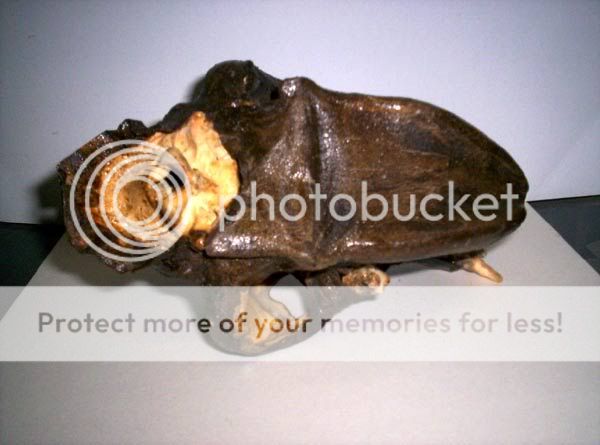
This one I'm not sure if it's real.

First thing to take notice are the two major tusk like teeth on its upper mouth. Second thing is to notice the head shape, mostly the eye location and position. Well my friends, look at this early whale head:
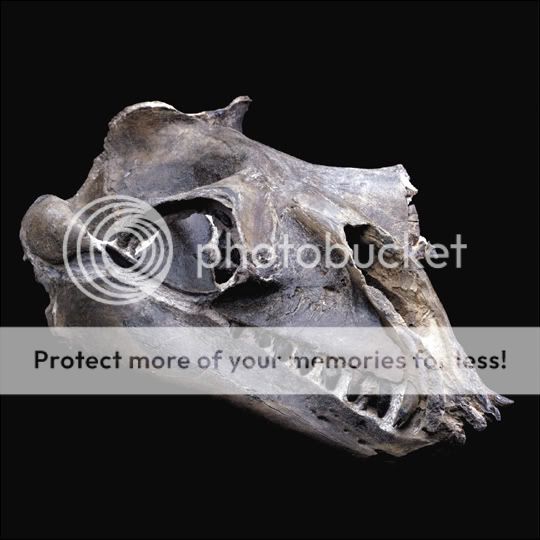
Better light in these:
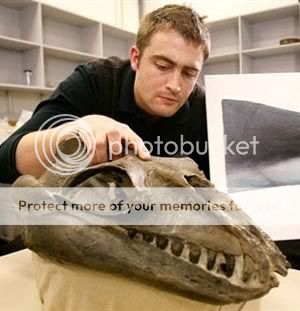
More evolved species
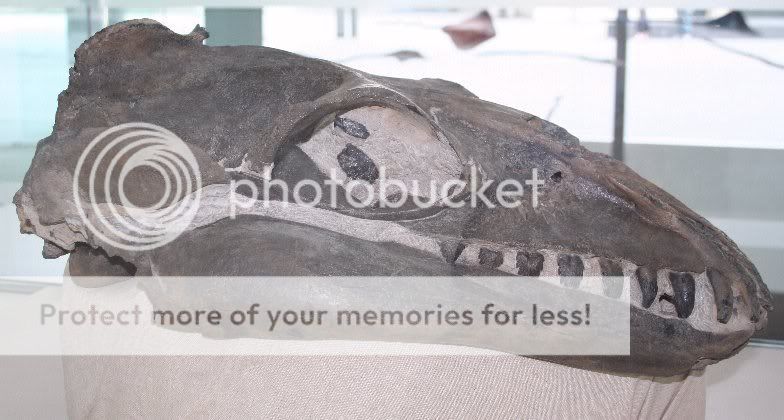
This is a species known as Janjucetus. It was a sea bearing whale, so this would be a species long after the break off between the two species we are investigating, but it would still be close enough to show evolutionary similarities.
For instance, take note at the outward teeth on the front. They go in the same shape as the two major teeth of the Chupacabra. Another thing is the Eye shape and location. Notice the high res Chupacabra skull and whale skull. They both have the same "brow bone" The whale's skull is a little lower, but the Chupacabra and Whale's eye are essentially clones of each other. Here is my comparison image:
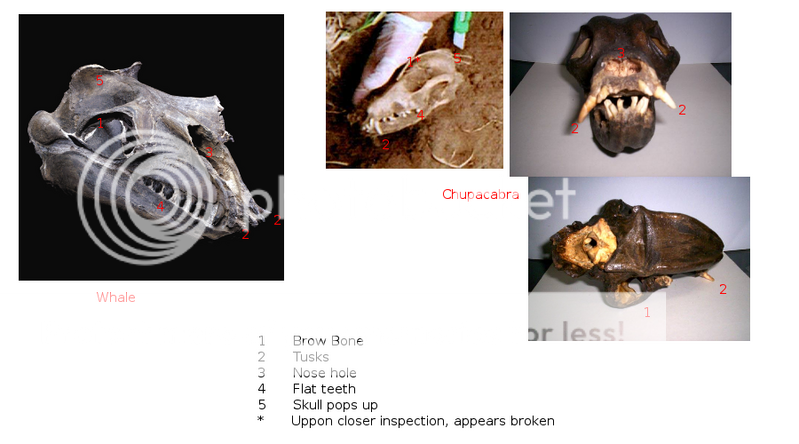
Next, we look at the body. Here are some examples of possible Chups (meaning Chupacabra here on)
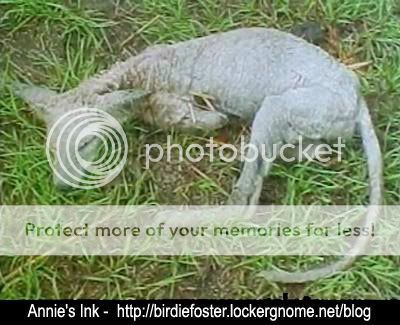


Along with some possible fakes, but presented just in case.

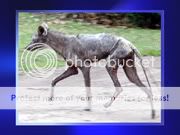

Now, as you see, they appear to be some sort of rat-dog-kangaroo crossbreed from hell. BUT, are they really all that different from the original land walking whales of the ancient times. Take a look and judge for yourself.
the Pakicetus
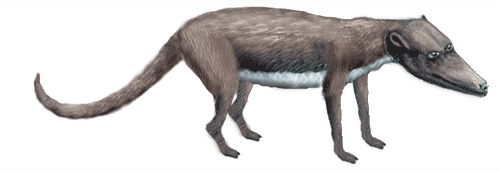
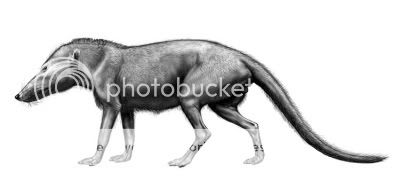
the Diacodexis

Notice the similarities of the body shape, height, tail, eyes, and limb alignment. Here is a comparative image.
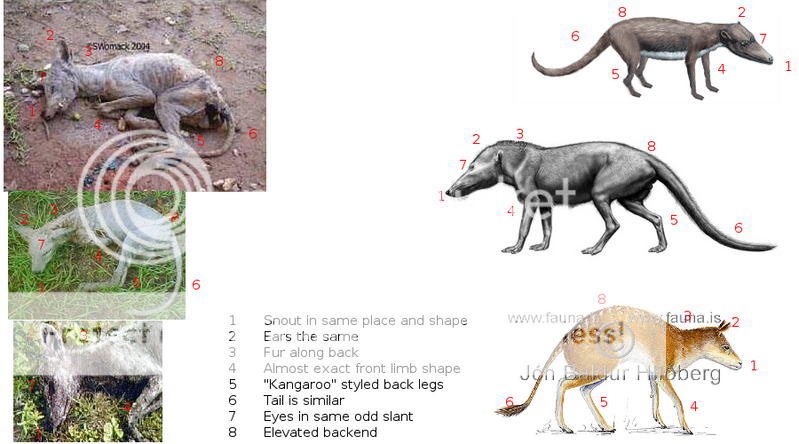
Now we will look at the skeleton. Supposedly, these are Chup skeletons.

These have some skin left on:


And the Whale skeletons we will compare:
Ambulocetus
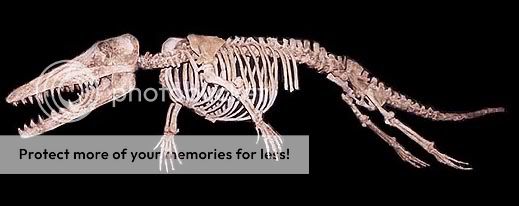

Etc, Etc
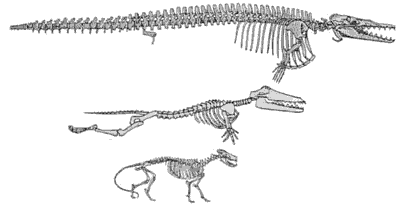
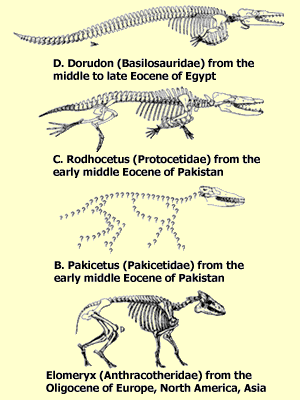

Pakicetus
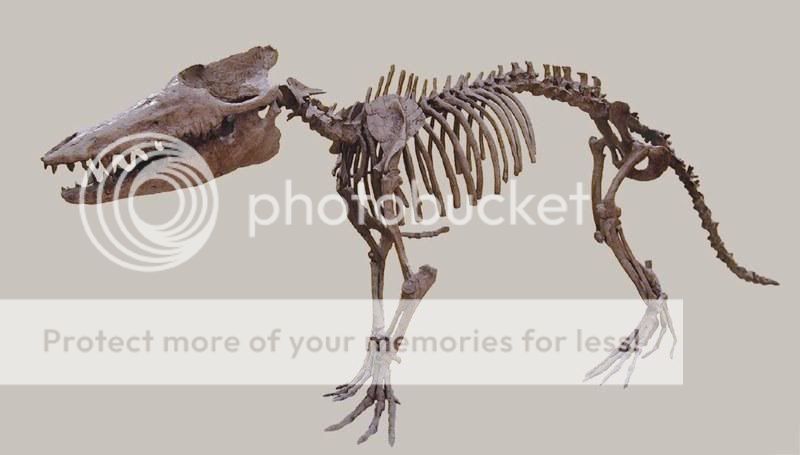
You already can see some similarities. Too bad that chup skeleton is missing legs, but on we go.
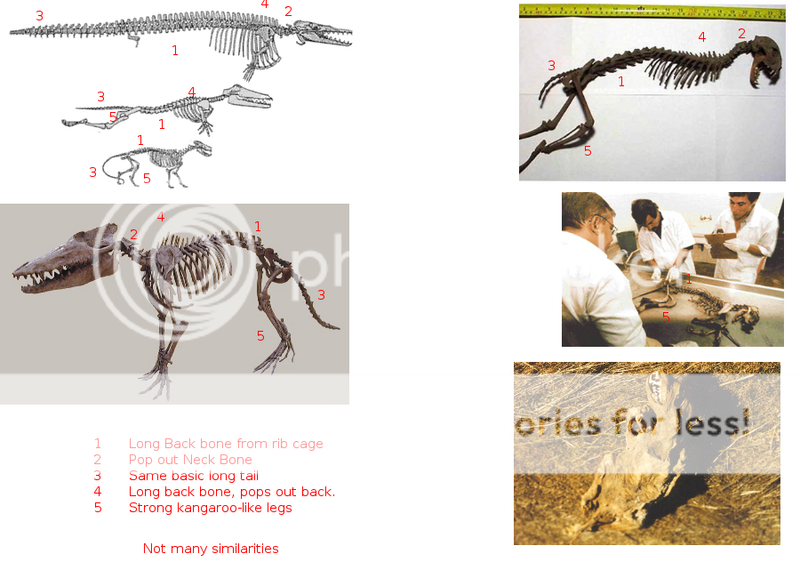
There are a few sames and differences, but similarities can be seen, especially with the back bone.
In the end, you can defiantly see the similarities between ancient whales and Chups. Look it up yourself, because it gets interesting.
NOTE: due to my lack of time to write this, a few images were shown but not compared. The key to this is your own eyes. It's 2:30 in the morning where I am, and I just wanted to present a quick theory for you all to mull over.
So please, comment and discuss.
In my opinion, the chups broke off from early whales, before they were aquatic. The rat-like early whale shows alot of similarities of chups, and so too do earlier creatures.
[edit on 5-9-2007 by Gorman91]
P.S. I want to make it clear that I have no idea WHEN the break off of whale and Chupacabra occurred, so I will be using various species of ancient whales. It is up to you, the viewer, to make the decision of where it broke off, as I'm no expert on the subject, just the presenter.
First up is the body. lets look at the head first.
Here are some images of a possible Chupacabra skull.


This one I'm not sure if it's real.

First thing to take notice are the two major tusk like teeth on its upper mouth. Second thing is to notice the head shape, mostly the eye location and position. Well my friends, look at this early whale head:

Better light in these:

More evolved species

This is a species known as Janjucetus. It was a sea bearing whale, so this would be a species long after the break off between the two species we are investigating, but it would still be close enough to show evolutionary similarities.
For instance, take note at the outward teeth on the front. They go in the same shape as the two major teeth of the Chupacabra. Another thing is the Eye shape and location. Notice the high res Chupacabra skull and whale skull. They both have the same "brow bone" The whale's skull is a little lower, but the Chupacabra and Whale's eye are essentially clones of each other. Here is my comparison image:

Next, we look at the body. Here are some examples of possible Chups (meaning Chupacabra here on)



Along with some possible fakes, but presented just in case.



Now, as you see, they appear to be some sort of rat-dog-kangaroo crossbreed from hell. BUT, are they really all that different from the original land walking whales of the ancient times. Take a look and judge for yourself.
the Pakicetus


the Diacodexis

Notice the similarities of the body shape, height, tail, eyes, and limb alignment. Here is a comparative image.

Now we will look at the skeleton. Supposedly, these are Chup skeletons.

These have some skin left on:


And the Whale skeletons we will compare:
Ambulocetus


Etc, Etc



Pakicetus

You already can see some similarities. Too bad that chup skeleton is missing legs, but on we go.

There are a few sames and differences, but similarities can be seen, especially with the back bone.
In the end, you can defiantly see the similarities between ancient whales and Chups. Look it up yourself, because it gets interesting.
NOTE: due to my lack of time to write this, a few images were shown but not compared. The key to this is your own eyes. It's 2:30 in the morning where I am, and I just wanted to present a quick theory for you all to mull over.
So please, comment and discuss.
In my opinion, the chups broke off from early whales, before they were aquatic. The rat-like early whale shows alot of similarities of chups, and so too do earlier creatures.
[edit on 5-9-2007 by Gorman91]
While you make an excellent argument, in the end they just they look like mangy/abused dogs/coyotes. And its been proven that most are.
[edit on 5-9-2007 by merka]
[edit on 5-9-2007 by merka]
Originally posted by merka
While you make an excellent argument, in the end they just they look like mangy/abused dogs/coyotes. And its been proven that most are.
[edit on 5-9-2007 by merka]
I agree, as I had said above "these may be fake", but the rat-kangaroo-dog things are especially odd. Even the skull gives me the creeps. Anywho, it's my 2 cents.
In the Dutch paper (www.telegraaf.nl) there where some photo's posted of a Chupacabra. It was found in Texas. I didn't see a post yet on this site
about it.
Its written in dutch. I maybe can make a brief translation but better is to find original american artical about it?
LINK
[edit on 5-9-2007 by Lunica]
Its written in dutch. I maybe can make a brief translation but better is to find original american artical about it?
LINK
[edit on 5-9-2007 by Lunica]
reply to post by Lunica
Yea I saw that, Looks like the ones above.
I forgot to add this whale thing
www.sciencenews.org...
[edit on 5-9-2007 by Gorman91]
Yea I saw that, Looks like the ones above.
I forgot to add this whale thing
www.sciencenews.org...
[edit on 5-9-2007 by Gorman91]
wow dude you really did some research that bieng said i do some simalarities but agree with gorman in regards to the whole chup thing in general
maybe the day when chup move from the crypto department into the areana of regular zoology you can re-present your research.to the world.anywho glad
to see people on this site doin research and tryina get things done so again
Let's pretend that the chupacabra is a real species on its own and not a mangy canine.
(I always love fresh and "out of the box ideas" and for that I applaud you.) And the conclusion is not exactly "groundbreaking". I'm afraid that there's a bit more to animal relations than looking similar. This is where Phylogenetics comes into play. The very complicated science of genetics and ancestral trees. The easiest way to trace these families are through the so-called Tree of Life. (Or if you're up for some serious thinking you can try this one. I think it's safe to start at Synapsida.
I think it's even safe if we skip ahead to Eutheria (placental mammals). Up to this stage they all had the same common ancestor, thus they all are related (genetically speaking). That means up to this point even you and I are related to the supposed "chupa".
I think before we continue it's important to note that when we speak of whales, we talk about animals that used to be a land-walking animal and then evolved to return to the ocean.
Whale Evolution
The most important part you may want to highlight for me is the following, taken from above source: (Emphasis mine.)
The wolf link, right? Quite, similar, not?
It is however very important to note the following (Emphasis mine):
Source
So, for the supposed Chupacabra to be related to the whale, it had/have to show these unique features. Or at least show signs that they had these characteristics at some stage. Another important point is that all artiodactyls evolved to return to the water - this could include the sister family hippopotamids (which speaks for itself). This is still being debated in the scientific community.
A possible connection between whale ancestors and canid ancestors would be ungulates (hoofed animals).
Source
However from the same source:
Did you spot it? There is indeed a common ancestor (presuming that the current evolutionary theory on whales is correct - this theory is debated). The common ancestor for both parties: Creodonts. But as I said - this is no surprise. And this means that even Paris Hilton's pooch is related to a whale. But waaay back...
So to conclude. Yes, if this "Chupacabra" is indeed a whole "new" species, then it will not be a surprise that the Chupacabra and whales have a common ancestor.
Still. Fresh thinking!
Edit: Grrr...ammar
[edit on 5-9-2007 by Gemwolf]
[edit on 5-9-2007 by Gemwolf]
(I always love fresh and "out of the box ideas" and for that I applaud you.) And the conclusion is not exactly "groundbreaking". I'm afraid that there's a bit more to animal relations than looking similar. This is where Phylogenetics comes into play. The very complicated science of genetics and ancestral trees. The easiest way to trace these families are through the so-called Tree of Life. (Or if you're up for some serious thinking you can try this one. I think it's safe to start at Synapsida.
Synapsids include mammals and all extinct amniotes more closely related to mammals than to reptiles. Synapsids are the dominant large terrestrial animals worldwide, and they have also invaded the oceans (whales, pinnipeds) and the air (bats).
I think it's even safe if we skip ahead to Eutheria (placental mammals). Up to this stage they all had the same common ancestor, thus they all are related (genetically speaking). That means up to this point even you and I are related to the supposed "chupa".
I think before we continue it's important to note that when we speak of whales, we talk about animals that used to be a land-walking animal and then evolved to return to the ocean.
Whale Evolution
The most important part you may want to highlight for me is the following, taken from above source: (Emphasis mine.)
In 1978, paleontologist Phil Gingerich discovered a 52-million-year-old skull in Pakistan that resembled fossils of creodonts -- wolf-sized carnivores that lived between 60 and 37 million years ago, in the early Eocene epoch. But the skull also had characteristics in common with the Archaeocetes, the oldest known whales. The new bones, dubbed Pakicetus, proved to have key features that were transitional between terrestrial mammals and the earliest true whales. One of the most interesting was the ear region of the skull. In whales, it is extensively modified for directional hearing underwater. In Pakicetus, the ear region is intermediate between that of terrestrial and fully aquatic animals.
The wolf link, right? Quite, similar, not?
It is however very important to note the following (Emphasis mine):
The pakicetids were carnivorous land animals, but are presumed to be ancestors of modern whales because of the three following features unique to whales: peculiarities in the positioning of the ear bones within the skull, the folding in a bone of the middle ear, and the arrangement of cusps on the molar teeth. The current theory is that modern whales evolved from archaic whales such as basilosaurids, which in turn evolved from something like the amphibious ambulocetids, which themselves evolved from something like the land-dwelling pakicetids.
Source
So, for the supposed Chupacabra to be related to the whale, it had/have to show these unique features. Or at least show signs that they had these characteristics at some stage. Another important point is that all artiodactyls evolved to return to the water - this could include the sister family hippopotamids (which speaks for itself). This is still being debated in the scientific community.
A possible connection between whale ancestors and canid ancestors would be ungulates (hoofed animals).
Dogs, ungulates (hoofed mammals), cats, bears, weasels, raccoons, civets and hyenas all share a common ancestor. Thus, the wolf and the animals it preys upon (the ungulates) evolved from a common ancestor from which they both inherited their intelligence and their ability to run swiftly for long periods of time. This common ancestor lived about a hundred million years ago. Most mammalian orders then differentiated during the Paleocene epoch (65 to 55 million years ago) and can be recognized from Eocene (55 - 33 million year old) fossils.
Source
However from the same source:
Roughly 55 million years ago, a mammal with carnassials (teeth used for tearing flesh) evolved from the creodonts.
..
It was during this time that the Miacis of the family Miacidae, from which the dogs, cats, bears, weasels, raccoons, civets and hyenas diverged from, appeared. The Miacidae included forms that varied greatly in size - some were as small as squirrels, while others were dog sized.
About 30 to 40 million years ago, Miacis (a tree-climbing animal with retractable claws) diverged into two types of mammals that gave rise to the dog and bear lineages. The Cynodictis line eventually gave rise to the dog family.
...
Did you spot it? There is indeed a common ancestor (presuming that the current evolutionary theory on whales is correct - this theory is debated). The common ancestor for both parties: Creodonts. But as I said - this is no surprise. And this means that even Paris Hilton's pooch is related to a whale. But waaay back...
So to conclude. Yes, if this "Chupacabra" is indeed a whole "new" species, then it will not be a surprise that the Chupacabra and whales have a common ancestor.
Still. Fresh thinking!
Edit: Grrr...ammar
[edit on 5-9-2007 by Gemwolf]
[edit on 5-9-2007 by Gemwolf]
Lol, very nice find indeed. Only one question..
The picture of the Chupacabra with the yellow ruler above is has been proven fake.. This means that the other creatures have long back bones for different reasons.
And why would whales need to have changed into little land carnivors in the first place
The canine - whale ancestor???
I dont really thing this could work, because dogs are a decendent of bears (or vise-versa :puz Which means that bears share the simmilar decendents or whales.. this seems very strange if it does prove to be true.
[edit on 5-9-2007 by Opulisum]
The picture of the Chupacabra with the yellow ruler above is has been proven fake.. This means that the other creatures have long back bones for different reasons.
And why would whales need to have changed into little land carnivors in the first place
The canine - whale ancestor???
I dont really thing this could work, because dogs are a decendent of bears (or vise-versa :puz Which means that bears share the simmilar decendents or whales.. this seems very strange if it does prove to be true.
[edit on 5-9-2007 by Opulisum]
Looking at the supposed chupacabra corpses shown in your photos Gorman91, I can see that they all more closely resemble modern known animals than
ancient Mesonichids or hippotamids.
Let's take a look, shall we?


It is missing its upper incisors, and its lower tusks. Otherwise it is easily recognizable as a pig's skull with some dried flesh on it.
You may not be sure if this one is real ...

... but I am. It is just the skull of a dog.
This ...

... also appears to be a dog.
This ...

... and the other similar photos are just coyotes ...
... with mange.
Back when I was in an animation course. I had to do an assignment where I had to take an animation of a cat, and redraw the animation as just the skeleton, and spent a few days carefully observing cat skeletons to get my drawings right. I can therefore say quite confidently that these ...


... are just unfortunate cats.
Let's take a look, shall we?


It is missing its upper incisors, and its lower tusks. Otherwise it is easily recognizable as a pig's skull with some dried flesh on it.
You may not be sure if this one is real ...

... but I am. It is just the skull of a dog.
This ...

... also appears to be a dog.
This ...

... and the other similar photos are just coyotes ...
... with mange.
Back when I was in an animation course. I had to do an assignment where I had to take an animation of a cat, and redraw the animation as just the skeleton, and spent a few days carefully observing cat skeletons to get my drawings right. I can therefore say quite confidently that these ...


... are just unfortunate cats.
Exactly why I don't even believe my own theory, it's just my opinion from looking at it. But while the skull appears similar to a pig's, it lacks
the same shape. The pig does not have a snout, nor the same eye placement.
I also mentioned some being possible fakes, but I said that I present them to represent those who say they are real. While the others appear cat like, they lack a few things. But I'll say you're right on the one missing the frontal legs.
I personally think the ones with kangaroo legs are not dogs, they do not have dog like characteristics.
And the one I was not sure of being real or not is indeed dog like, thanks for the find.
The dogs with mange appear similar, but lack the same head.
As for why the whale would evolve to a blood sucking thing, you completely missed the point. I said the ancient whales, key word being ancient. They were land walking giant rodents that looked like rat dogs.
In the end, all legends originate from some form of reality. And the proof is in the blood drained chickens and other such left behinds.
I personally see similarities between early whales and chups.
I also mentioned some being possible fakes, but I said that I present them to represent those who say they are real. While the others appear cat like, they lack a few things. But I'll say you're right on the one missing the frontal legs.
I personally think the ones with kangaroo legs are not dogs, they do not have dog like characteristics.
And the one I was not sure of being real or not is indeed dog like, thanks for the find.
The dogs with mange appear similar, but lack the same head.
As for why the whale would evolve to a blood sucking thing, you completely missed the point. I said the ancient whales, key word being ancient. They were land walking giant rodents that looked like rat dogs.
In the end, all legends originate from some form of reality. And the proof is in the blood drained chickens and other such left behinds.
I personally see similarities between early whales and chups.
Good analysis people. I was looking for whale characteristics on the chupa's skull, and saw a relative similarity that I pointed out. Here, I'll go
more in depth.
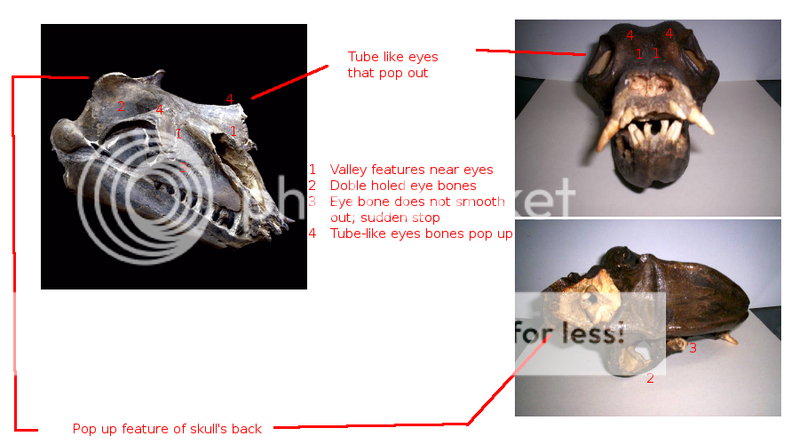
NOTE: I meant "double Holed Eye Bones" on number 2.
And as for the cat and pig's skull being like the chups, here is my analysis.
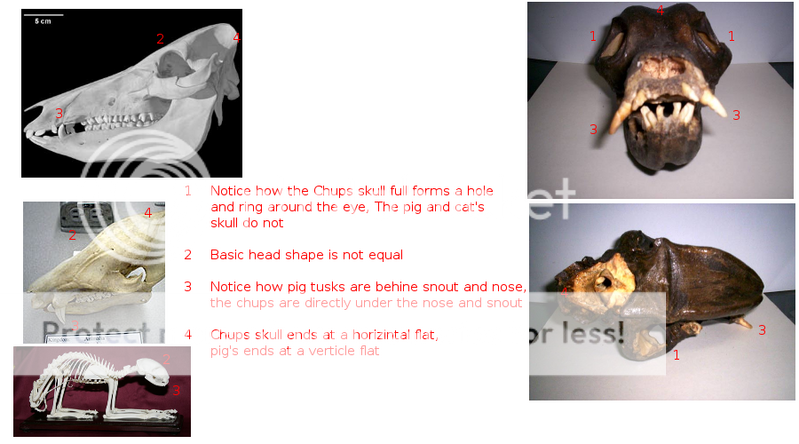
Once again, I think it looks similar to these mammals, but it shows many more characteristics of an early whale then any other thing.
[edit on 5-9-2007 by Gorman91]
wrong picture uploaded
[edit on 5-9-2007 by Gorman91]
[edit on 5-9-2007 by Gorman91]

NOTE: I meant "double Holed Eye Bones" on number 2.
And as for the cat and pig's skull being like the chups, here is my analysis.

Once again, I think it looks similar to these mammals, but it shows many more characteristics of an early whale then any other thing.
[edit on 5-9-2007 by Gorman91]
wrong picture uploaded
[edit on 5-9-2007 by Gorman91]
[edit on 5-9-2007 by Gorman91]
2 Basic head shape is not equal
That is because you are comparing the CAT skeleton I posted with the skull I said belongs to a PIG. The cat skeleton pictures I posted were set along side the cat skeleton "chupacabras", not the pig skull. You are comparing the wrong things.
Can we all say "straw man" boys and girls?
I have a list of things to say, but I will wait until later to post.
Meanwhile, the pig skull "chupacabra" is said to be currently on display in an antique store somewhere in Hamilton Ontario ( www.coasttocoastam.com... ). If somebody can find out which one, I am more than willing to drive over there and take a look at this thing myself. It is a five hour drive each way, but I am willing to do it.
The fact that the skull was photographed with a wide angle lens (which makes the snout and the teeth therein look bigger), the fact that the skull is tipped up at an odd angle in its front view (note that the chin is not touching the surface of the table), and the fact there is no side view or top view, with only an odd bottom view that doesn't show very much, makes me suspicious. Why should they fail to show the profile, possibly the most important view?
Me thinks it be because it be just a wild pig's skull with the lower tusks removed to make the upper tusks look like fangs.
[edit on 5-9-2007 by Boingo the Clown]
reply to post by Boingo the Clown
No, I was comparing the pig and cat skull to the chups, they don't look alike. Even with a wide range camera, the tusks are all in the wrong place, and the nose and eyes are different.
But hey, if you're willing to go see the skull, I'd really like a 360 degree look. It's a bad angle to see any skull part that pops up: the feature on all whales. The supposedly chup's skull has no back visible, just what appears to be a poping up skull.(damn eye brow bones are blocking it)
The main feature of the skull is that it has a complete ring of bone around the eyes, which neither pig nor cat nor dog has.
But it would be really useful to get some more images.
No, I was comparing the pig and cat skull to the chups, they don't look alike. Even with a wide range camera, the tusks are all in the wrong place, and the nose and eyes are different.
But hey, if you're willing to go see the skull, I'd really like a 360 degree look. It's a bad angle to see any skull part that pops up: the feature on all whales. The supposedly chup's skull has no back visible, just what appears to be a poping up skull.(damn eye brow bones are blocking it)
The main feature of the skull is that it has a complete ring of bone around the eyes, which neither pig nor cat nor dog has.
But it would be really useful to get some more images.
The thing is, these modern things don't match the ancient stories of chupacabras. The idea that they're doglike/catlike/kangaroolike cam up only in
the past 20 years or so. Before that, they were batlike.
Until someone comes up with a REAL chupacabra, it's better to go look at the oldest legends and see what they say.
And they say that chupacabra is a ghost-demon.
Oh... and the real skeletons/body bits are a pig, some dogs, and some cats. I remember the skeletons from when I took comparative anatomy in biology in college a very long long time ago.
[edit on 6-9-2007 by Indellkoffer]
Until someone comes up with a REAL chupacabra, it's better to go look at the oldest legends and see what they say.
And they say that chupacabra is a ghost-demon.
Oh... and the real skeletons/body bits are a pig, some dogs, and some cats. I remember the skeletons from when I took comparative anatomy in biology in college a very long long time ago.
[edit on 6-9-2007 by Indellkoffer]
yes because as i do know the chupacabra is alot more complex and has even tentacle like appendages.and a more thicker tail
reply to post by Indellkoffer
Humans have a tendency to over exaggerate on something. You see it everyday. If you look at some descriptions, however, it is a flying thing with spikes down its back and two fangs. Dog like to alien like additions to this are seen thought various parts of Mexico. All I know is that, whether it be a chupeacabra or not, there is certainly a blood sucking vermin out there, and its skull and possible photos look like an ancient whale. As for the brown skull first shown, it still remains unique in that the eye brow bone is a complete ring and back open hole, shared by whales. Some wolves have the characteristic, but not like the skull.
[edit on 6-9-2007 by Gorman91]
Humans have a tendency to over exaggerate on something. You see it everyday. If you look at some descriptions, however, it is a flying thing with spikes down its back and two fangs. Dog like to alien like additions to this are seen thought various parts of Mexico. All I know is that, whether it be a chupeacabra or not, there is certainly a blood sucking vermin out there, and its skull and possible photos look like an ancient whale. As for the brown skull first shown, it still remains unique in that the eye brow bone is a complete ring and back open hole, shared by whales. Some wolves have the characteristic, but not like the skull.
[edit on 6-9-2007 by Gorman91]
ok i use to be positive that the chupacabra was real...but i researched it and found that all the animals that have claimed to be
eaten or devoured by the chupacabra just die of natural causes. the heat would cause the animal to bloat...and a type of maggot makes the surgical
cuts....and ants also help in the break down process....i am thinking that the chupacabra is made up...but im still looking for evidence...and ur pics
do lead somewhere....
Originally posted by Indellkoffer
Oh... and the real skeletons/body bits are a pig, some dogs, and some cats. I remember the skeletons from when I took comparative anatomy in biology in college a very long long time ago.
I am glad to see you agree with me.
I think, after looking it up more, the skeletons are cats and dogs. I know for a fact that the first skull shown is not dog, cat, or pig due to tooth
and eye alignment. But the others seem similar.
reply to post by Gorman91
I saw that on the discovery channel so though i'd check it out....i stumbled upon this website and i think ur on to something dude.....although it does look like a mangy kanine/kangaroo thing
I saw that on the discovery channel so though i'd check it out....i stumbled upon this website and i think ur on to something dude.....although it does look like a mangy kanine/kangaroo thing
new topics
-
The official representative of Russia reported about concentration camps for Russians
World War Three: 1 hours ago -
Conservatives and liberals have different brain structures
Political Ideology: 3 hours ago -
Eritrean gangs clash in 10-hour riot during 'cultural celebration' North Carolina
Social Issues and Civil Unrest: 4 hours ago -
American Taxpayers Fund Hezbollah Terrorist Memorial In Dearborn Michigan
Social Issues and Civil Unrest: 5 hours ago -
Kamala Harris tells Oprah she will kill an intruder
US Political Madness: 7 hours ago -
Illegal Alien brothers arrested in Missouri for connection with deadly carjackings
Social Issues and Civil Unrest: 8 hours ago -
Teenage Girl Raped and Woman Sexually Assaulted on Brighton Beach
Social Issues and Civil Unrest: 10 hours ago -
When locals can spot your counterfeit pandas
Jokes, Puns, & Pranks: 11 hours ago
top topics
-
BIDEN-HARRIS DOJ-DHS Blocked Florida Law Enforcement from Investigating Would-Be Trump Assassin.
US Political Madness: 14 hours ago, 22 flags -
Kamala Harris tells Oprah she will kill an intruder
US Political Madness: 7 hours ago, 15 flags -
My latest form of art…
Member Art: 16 hours ago, 13 flags -
Sept 2024 - MATT GAETZ Reveals There Are FIVE Trump Assassination Teams in the USA Right Now.
2024 Elections: 13 hours ago, 13 flags -
Illegal Alien brothers arrested in Missouri for connection with deadly carjackings
Social Issues and Civil Unrest: 8 hours ago, 12 flags -
Eritrean gangs clash in 10-hour riot during 'cultural celebration' North Carolina
Social Issues and Civil Unrest: 4 hours ago, 11 flags -
Teenage Girl Raped and Woman Sexually Assaulted on Brighton Beach
Social Issues and Civil Unrest: 10 hours ago, 10 flags -
American Taxpayers Fund Hezbollah Terrorist Memorial In Dearborn Michigan
Social Issues and Civil Unrest: 5 hours ago, 6 flags -
Conservatives and liberals have different brain structures
Political Ideology: 3 hours ago, 5 flags -
When locals can spot your counterfeit pandas
Jokes, Puns, & Pranks: 11 hours ago, 4 flags
active topics
-
My latest form of art…
Member Art • 38 • : BingoMcGoof -
-@TH3WH17ERABB17- -Q- ---TIME TO SHOW THE WORLD--- -Part- --44--
Dissecting Disinformation • 2672 • : Thoughtful3 -
Ukraine hit 300 miles into Russia
World War Three • 172 • : Oldcarpy2 -
Teenage Girl Raped and Woman Sexually Assaulted on Brighton Beach
Social Issues and Civil Unrest • 65 • : Terpene -
Conservatives and liberals have different brain structures
Political Ideology • 17 • : Athetos -
The Acronym Game .. Pt.4
General Chit Chat • 468 • : tinkerbell99 -
Russia Ukraine Update Thread - part 3
World War Three • 6588 • : Oldcarpy2 -
Israel Launches 2nd Wave Of EXPLODING TECH, Hezbollah Radios Begin Exploding
World War Three • 65 • : andy06shake -
20 Supporters Seated Behind Trump Onstage Rushed to Hospital
2024 Elections • 36 • : IndieA -
Sept 2024 - MATT GAETZ Reveals There Are FIVE Trump Assassination Teams in the USA Right Now.
2024 Elections • 17 • : Degradation33
